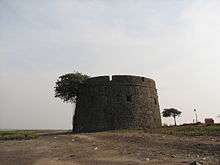Arnala fort
| Arnala fort | |
|---|---|
| Part of the Maratha Empire | |
 Arnala fort bastion viewed through one the fort's windows | |
 Arnala fort | |
| Coordinates | 19°27′57″N 72°43′57″E / 19.46577°N 72.73247°ECoordinates: 19°27′57″N 72°43′57″E / 19.46577°N 72.73247°E |
| Site information | |
| Controlled by |
Bijapur
|
| Open to the public | Yes |
| Condition | Protected Ruins |
Arnala Fort is built on a small island of the port town of Arnala, located around 8 miles north of Vasai, Maharashtra, India.[1] Being an island fort, it is also called Jaldurg or Janjire-Arnala. The Portuguese, who built the present fort,[2] called the island Ilha das vacas.
History
In 1516 a local chieftain in Gujarat, Sultan Mahmud Begda, constructed the fort on the island, strategically located at the mouth of the Vaitarna river. In the 1530s the Portuguese had established their operations in the coastal area, headquartered at Fort Bassein, and soon gained control of the island. The Portuguese captain of Bassein donated the island to a Portuguese nobleman who tore down the old fort and began construction of a 700-by-700-foot (210 m × 210 m) fort. The nobleman never completed the fort. Still, it remained under Portuguese control for two centuries; they used it to control shipping and navigation along the northern Konkan coast.
During the late 17th and early 18th centuries, after a long struggle with the Mughal Empire, the Maratha Confederacy came to dominate present day Maharashtra. In 1737 the then Peshwa Baji Rao I sent his brother, Chimaji Appa, to take the Bassein Fort from the Portuguese. After winning the Battle of Vasai, his general, Shankarji Pant, persuaded Chimaji to launch an assault on Fort Arnala, for its strategic importance to the Maratha navy in assaulting Portuguese interests. Their first assault, coordinated with a Maratha naval force commanded by Manaji Agre, was routed by a superior Portuguese naval force. A second assault on the fort on 28 March 1737, caught the Portuguese by surprise and forced them to abandon the fort. The victory was commemorated by a plaque installed on the northern wall of the fort and is still visible today. The Marathas then rebuilt the fort, constructing three bastions Bahirav, Bhavani, and Bava.
The British captured the fort on 18 January 1781 during the First Anglo-Maratha War.[3]
The Marathas controlled the fort until 1817. During the third British-Maratha war, despite successfully defending the fort, the Marathas were forced to surrender the fort to the British due to their superior naval power. The treaty of Salabai returned the Arnala and Bassien forts to the Marathas, but the British regained the forts under the Treaty of Poona. Today the fort is in a state of disrepair.[4]
Features

Octagonal Water Reservoir and Temples
There is a large octagonal fresh water reservoir inside the fort. Inside the fort are the temples of Ambakeshwar, the goddess Bhavani, Lord Shiva, and the tombs of Shahali and Hajjali. The 'paduka' or sacred sandals of Shrinityanand Maharaj are housed in a dome on the eastern face of the fort.
The Entrance
The main entrance of the fort faces approximately north.

The solid stone doorway is adorned with pictures of tigers and elephants.

Ramparts and Walls
The external ramparts are in a fairly good condition, and a roughly three-meter-wide path exists along the outer walls. .[5]
Southern Watch Tower
There exists a lone Martello tower about 550 meters from the main fort, on the southern end of the island. This tower has no entrance gate.

See also
References
- ↑ "Friends of Forts". Archived from the original on 2009-04-05. Retrieved 2009-02-03.
- ↑ Scholberg, Henry (1995). Fortress Portugal in India. NorthStar Publications. Retrieved 2009-02-02.
- ↑ Naravane, M.S. (2014). Battles of the Honorourable East India Company. A.P.H. Publishing Corporation. p. 61. ISBN 9788131300343.
- ↑ Naravane, A.V.H. (1998). The Maritime and Coastal Forts of India. APH Publishing. pp. 43–44. ISBN 81-7024-910-4. Retrieved 2009-02-02.
- ↑ Kantak, M.R. (1993). The First Anglo-Maratha War, 1774-1783: A Military Study of Major Battles. Popular Prakashan. p. 150. ISBN 81-7154-696-X. Retrieved 2009-02-02.
External links
| Wikimedia Commons has media related to Fort Arnala. |
- Arnala Fort Pictures Pictures of Forts in Maharashtra
- Arnala Fort Page A Vasai Cultural Information Website in GeoCities.
- Arnala fort Trip A Blog Post on Arnala by a blogger.
- Arnala Fort & Jivdani Temple - * How to go, places to visit, things to do
- Trekking Tourism - Virar - विरार - ویرار